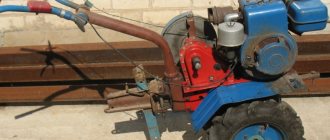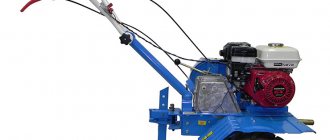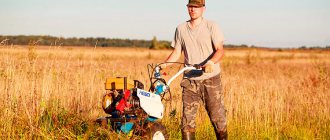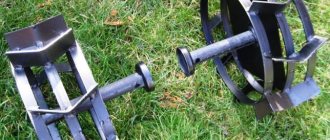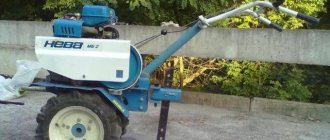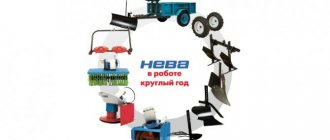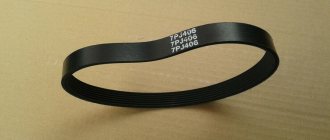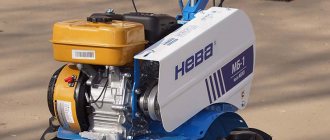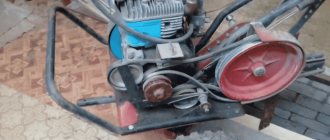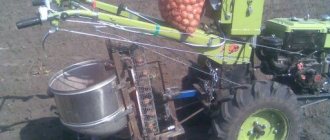Technical recommendations
Before choosing a walk-behind tractor, or rather its model or belts, in order to repair the unit, you should first study not only the characteristics of the equipment, but also the land itself, which will need to be processed in the future. If any spare part is selected correctly, the unit from the Salut company can easily cope with the following tasks assigned to it:
- hilling;
- harvesting;
- plowing potato crops;
- fertilization;
- harrowing;
- landing.
In addition to the characteristics of the future harvest, it is worth paying attention to the characteristics of the soil. If heavy soil is considered, the unit must be equipped with a powerful timing belt of the generator
Given its purpose, it is used to create a drive between the camshaft and the crankshaft. If the tension is insufficient, the shaft may pop out. This will also reduce the actual power of the device.
Considering all of the above, we can conclude that the efficiency of the walk-behind tractor depends on the correctness and quality of the choice of any element of the system. At the same time, the manufacturer does not set restrictions related to the selection of spare parts or their analogues.
This is interesting: the dimensions of the belt for the Oka walk-behind tractor.
Operating at higher speeds
Expensive modifications of walk-behind tractors are equipped with several speeds. The designated function allows you to optimize the procedure for sowing, harvesting or cultivating a field. But on the other hand, the operation of walk-behind tractors largely directly depends on the quality of the drive belt. The first thing to remember is that frequent gear shifting does not have the best effect on the operation of the unit. For this reason, you should avoid using cheap and sometimes low-quality products.
Belt sizes for the Neva walk-behind tractor
When selecting the appropriate consumables, it is important to determine the number of the belt installed on the model of the Neva walk-behind tractor. To do this, the following recommended measures should be taken:
- the old consumable element is removed from the walk-behind tractor using a special tool and technology;
- then the device is checked for the presence of numbers (usually there are values on the outer surface);
- As a rule, the belt number used for a Neva walk-behind tractor is white, blue or orange;
- if these figures are missing due to long-term use of special equipment, then the distance between the rotating elements is measured;
- Next, you should use a special table (a table with values is available on the manufacturer’s website) to determine the size;
- also, if necessary, you can check the required parameter with the seller, since this data is also available in stores;
- then the same model is purchased, which will be freely mounted on rotating mechanisms.
Don’t forget to choose the right belt size.
It is recommended that after purchasing a new consumable item, copy the number from its surface so that you do not have to look for the values again later. The cost of this element is quite high, which is why you should have accurate information.
Gearbox
Owners of Oka walk-behind tractors, like any other equipment, sometimes encounter operational problems. Including the operation of the gearbox.
Next, we will look at the most common difficulties, their probable causes and ways to solve the problem:
- There is oil leaking on the output shaft: the axle shaft cuff may be worn out (replacing the cuff will help);
- the gearbox is jammed (one of the reasons is a broken chain; it needs to be replaced);
- it is not possible to change gears (you need to disassemble the gearbox and replace broken parts);
- the mechanism for disengaging the axle shafts is broken (adjusting the tension of the axle shaft control cable will help).
The figure below shows a cross-sectional diagram of the walk-behind tractor gearbox
If the normal operation of the oil seals is disrupted, namely when oil leaks, the oil seals should be removed and inspected for cracks and wear. Replace if necessary.
Recommendations for use
To ensure that the components for the Cascade walk-behind tractor wear out less, it is used carefully. Experienced summer residents advise:
- check the mini-tractor for defects upon purchase;
- carefully read the attached instructions in order to properly use and store the equipment;
- do not bend or stretch parts;
- do not keep the device in conditions of high humidity;
- Before use, sometimes check the pulley to remove scratches, chips, and cracks;
- buy components only in reliable stores, choosing parts intended for a specific model and produced by the manufacturer of the agricultural machine;
- When one of the belts wears out, change the front and rear belts at once so that their condition is the same.
If the work to be done on the site is simple, it is recommended to loosen the parts. This will extend the life of the walk-behind tractor.
Drive belt maintenance
The V-belt is the main part of the walk-behind tractor clutch. Its service life depends on the work for which agricultural machinery is used. As a rule, if the MB is used as a propulsion device for a cart, mower or drive for a mill or planing attachment, the rubber parts of the clutch mechanism can last for several years. If the device is used for plowing and cultivating heavy, wet clay arable land, the load on it is very large and several belts may wear out during the spring season.
For long-term uninterrupted operation of the clutch mechanism, you must do the following:
- When filling oil and gasoline into the engine of an agricultural machine, technical fluids are not allowed to come into contact with the rubber parts of the mechanism. Petrochemical products destroy the rubber surface, belts wear out quickly;
- Do not press the forward and reverse levers at the same time. When pressed simultaneously, tension and jamming of both belts occurs, and the walk-behind tractor fails;
- Do not operate agricultural machinery with cracks on the surface of parts. During operation, pieces of rubber can fly out and injure the person working on the walk-behind tractor;
- It is not permitted to install spare parts of a different size or profile. A short belt will quickly burn out from strong tension and pressure against the motor shaft, a long belt will slip and the device will not be able to operate. Installing a smaller profile part will shorten the life of the clutch mechanism. A larger profile for installation and operation will require the removal of protective covers, which can lead to injury;
- The clutch must be adjusted correctly. A strong belt tension quickly disables it; if it is weak, the engine will develop excessive power, which simply will not reach the transmission parts.
V-belts are an important part of the walk-behind tractor mechanism. The operation of the mechanism depends on their condition. Replacing the drive belt yourself will require a common set of tools and is quite within the capabilities of a gardener. Regular inspection, maintenance and timely replacement will protect equipment from breakdowns.
Carburetor adjustment
The carburetor valves of the walk-behind tractor require periodic adjustment. Violation of the norm of the distance between the valves causes a change in the periodicity of the gas distribution stages, as a result, the engine does not reach the declared power. If the gap is large, noise appears and the valves themselves become deformed.
As soon as any extraneous noise appears in the engine during operation of the walk-behind tractor, the carburetor should be adjusted. To adjust, you need a screwdriver, a wrench and a blade (after all, the valve clearance norm is from 0.1 mm to 0.15 mm).
The MB-1D walk-behind tractor uses a membrane-type carburetor, model DM 1.08.100. The external view of the DI1.08.100 carburetor is shown in the figure below:
Rules for selecting belts
Neva walk-behind tractors have been produced by the St. Petersburg JSC “Red October-Neva” for more than 35 years. On sale there are modifications MB-1, MB-2, MB-23 (with a Subaru engine), MB-2K and others. The devices are equipped with engines of different manufacturers and modifications. For each set, a different type and size of V-belts are used for the Neva walk-behind tractor.
On a note! As a rule, the markings and numbers of the required spare parts can be found in the service book attached to the walk-behind tractor.
To move the MB-1, you need two V-belts (forward and reverse). The Neva MB-2 walk-behind tractor and its modifications use only forward gear, so it only requires one belt.
Many companies produce rubber products for automotive and agricultural machinery. Rubber products from Gates, ContiTech and Optibelt have become world famous. The products of the Balakovorezinotekhnika (BRT) and Rosteco factories are famous in the Russian Federation. All rubber products are unified in length and profile, so parts from different manufacturers must fit the walk-behind tractor. The price of parts depends on their profile, belt size and manufacturer and can range from 300 to 700 rubles.
To select a belt for the Neva walk-behind tractor, use the following table
| Modification of the device | Applicable parts |
| MB-1 old release | For vertical movement, A-1180 VN-T GOST 1284.1-80 or GOST 1284.3-80 is used To drive in reverse, you need 0-1400T GOST 1284.1-80 or GOST 1284.3-80 |
| MB-1 | A53 length 1380 mm |
| MB-2 | A-45 13*1143 Li A1180Ld or A1180 GOST 1284.2-89 |
| MB-2S-9.0 PRO | A-46.5 A (1213) |
| MB-3 | A52 13*1320 Li A1350 Ld |
| MB-23 | A49 or A50 13*1270Li A1300Ld |
| MB Compact | A47 1200 Li A47 (1230 Prof A) |
| MK-75 | FSCOUZ36 |
| MK-80 | А37 13940 Li А979 Ld |
| MK-80R | Z 31 ½ 10*805 Li Z825 Ld |
| MK-100 | A 100 GOST 1284.1-89 |
| MK-200 | A 44 |
Knowing the name of the spare part, you can order it at a specialized workshop for repairing agricultural machinery or purchase it at a regular store that sells parts for cars and agricultural machinery.
Engine
Depending on the modification, the Oka walk-behind tractor is equipped with engines from different manufacturers (DM-1M, DM-1M1, MITSUBISHI GT600 6.0/4.4, I/C 6.0 HP 6.0/4.4, Honda GX-200 6.5/4.8, Lifan 168 F-2A 6.5/4.8, Vanguard 6.5 HP 6.5/4.8, Lianlong 168F-1A 6.5/4.8, Robin Subaru EX 17 6.0/4.4, Robin Subaru EX21 7.0/5.2, KADVI 168F-2A).
One of the popular modifications is the Oka with the Lifan engine . This engine is economical, and its functionality allows it to be installed in small-sized equipment (motor cultivators, walk-behind tractors). Lifan is manufactured in China and has proven itself to be a durable and reliable engine.
The choice of model is made depending on the area of land the operator intends to cultivate using the walk-behind tractor, as well as on the main tasks (plowing, cultivation, digging up potatoes, etc.) that the device will perform.
Engine malfunctions
Let's figure out why the engine on the Oka walk-behind tractor may be acting up? So, the main reasons that the engine does not work and the walk-behind tractor does not start may be the following:
- insufficient fuel or oil level;
- low-quality gasoline;
- clogged fuel or oil filter;
- problem with spark plugs or seals (oil is leaking; spark plugs need to be replaced);
- the angle of inclination when setting up the walk-behind tractor is exceeded (more than 15 degrees, start the walk-behind tractor on a flat surface);
- the integrity of the electrical wiring is compromised;
- rupture or delamination of transmission belts;
- poor tire pressure in combination with any of the above reasons;
- attempt to start the engine without warming up;
- The storage temperature of the walk-behind tractor is too low, as well as a big minus outside when starting the equipment (store the walk-behind tractor in a warm room; in sub-zero temperatures, pour warm oil into the engine and gearbox).
In order to tension the belt on the Neva MB-2 walk-behind tractor, we need:
- inspect the pulley for contamination with soil particles and, if necessary, remove all excess from the installation grooves;
- using a universal wrench, unscrew the nuts, thereby freeing the frame on which the motor part is located;
take an 18 mm wrench and place it on the thread of the adjusting bolt and turn it clockwise, thereby bringing the engine closer and pulling it towards you. It is advisable to periodically check the belts by hand: if they are correctly tensioned, they spring easily and quickly return to their previous position when loaded. An overtightened belt is also a problem that will cost the bearing that holds the motor pulley;
- we check whether the motor is skewed, which is often observed with these walk-behind tractors. If this nuance occurs, loosen the adjusting screw by one turn and fix the nut located on the opposite side of the housing from the belt drive. This makes it possible, on the one hand, to accurately fix and immobilize it on the frame, and on the other hand, to leave it movable for alignment;
- tighten the bolts (4 pcs. in total).
The tension of the drive belt on the MB-1 walk-behind tractor looks slightly different. It is produced using a clutch lever, which is most often installed on the left handle.
For the new MB-1 walk-behind tractor, which is just getting ready for operation, the course of action will be as follows:
- unscrew the clamp screw;
- We place the lever on the left side of the steering wheel, aligning its fastening with the fastening of the clamp;
- tighten the fastenings with a screw tie;
- When turning the clutch adjusting screw, monitor its tension: when the load is created by the fingers, the deviations should not exceed 10 mm.
Adjusting the belt on the Neva MB-1 walk-behind tractor after repairing or replacing the belt drive comes down to only adjusting the clutch lever screw. Correct adjustment will be indicated by the immobility of the gear pulley when the engine is turned on and slight sagging of the belts when the clutch handle is lowered.
For the Neva MB-2 and MB-1 walk-behind tractors, it is important to check the serviceability and tension the belt drives every 25 hours of operation. The following will help increase the “lifespan” of these parts:
The following will help increase the “lifespan” of these parts:
- elimination of pulley misalignment;
- installation of a damper;
- shortening the rocker arm or installing a longer reverse gear belt (for MB-1).
Run-in
After installing a new product, it is necessary to run in the walk-behind tractor without putting a load on it, so as not to damage the structural elements. When using the unit, it is necessary to tighten the gear mechanisms after every 25 hours of operation. This will prevent rapid wear of the friction wheels and ensure smooth movement of the walk-behind tractor itself.
To learn how to change the belt on a walk-behind tractor, see the following video.
Replacing the V-belt
After purchasing a spare part, you can replace it yourself. To do this you will need a set of keys. To preserve the edges of nuts and bolts, it is better to use socket heads. Each modification of the walk-behind tractor has its own characteristics, so the procedure for replacing spare parts varies.
Replacement of worn parts on the MB-1 walk-behind tractor
On the old model of the walk-behind tractor, two belts are installed for forward and reverse movement. To replace them, do the following:
- agricultural machinery is cleaned of dirt;
- unscrew the fastening bolts and remove the protective casing;
- loosen the screws securing the guide plate, move it upward;
- By pressing the tension roller down with your hand, the worn parts are removed. If it is necessary to replace the reverse belt on the MB-1 walk-behind tractor, first remove the forward one;
- new parts are installed to replace worn ones;
- the guide plate is put in place, the screws are tightened;
- install protective covers in place;
- check how the belt moves along the pulleys, finally tighten the bolts and nuts securing the protective casing.
On a note! It is strictly forbidden to use excessive force to tighten the screws securing the guide plate, as this may lead to breakage of the threads and destruction of the motor housing of the device.
Replacing the belt on the Neva MB-2 walk-behind tractor
On new walk-behind tractors, torque is transmitted using a single belt. To replace it, do the following:
- clean the mechanism from dirt and soil;
- unscrew the mounting bolts, remove the protective covers;
- loosen the tension roller;
- remove the bracket;
- remove the worn part;
- install a new belt. First, it is put on the motor shaft, then on the gear pulley;
- install the bracket in place;
- by moving the bracket up and down, adjust the belt tension;
- install protective covers in place;
- by rotating the pulley, check the ease of movement of the belt and the absence of distortions;
- Finally tighten the mounting bolts of the bracket and casings.
Varieties
Unit belts are:
- wedge;
- toothed;
- forward travel;
- reverse.
To ensure optimal tension and long service life of not only the entire belt drive, but also the transmission, the size of the unit belt must be precisely selected for a specific modification of the walk-behind tractor. If you place extremely long products, as well as very short ones, they will wear out quite quickly and create an extra load on the engine or gearbox. For example, a 750 mm “Mole” belt drive is installed on units with a domestic engine.
In addition to the above, before purchasing, you need to check the outside of the product: the belt should not have damage, scratches, protruding threads, or kinks. A high-quality product is one that retains a distinct factory pattern and cannot be stretched by hand.
Features and functions of belts
While it will be easy to find a replacement for a worn-out link on a Chinese walk-behind tractor, the maintenance of Perm Cascade mini-tractors is associated with certain difficulties. There are not many walk-behind tractors of this brand on the market, but each model requires its own components. If you ignore the specifics of the model, the purchased belts will quickly break and the device itself will break. Therefore, when choosing a new part, be sure to look at the instructions and look at the marking number on the worn-out element.
Interesting! The drive V-belt for the Cascade is made of polyurethane or rubber.
This component affects the quality of land cultivation. Its main function is to transmit movement. If the length of the rubber ring increases due to stretching, the tension becomes insufficient and the shafts begin to slip. As a result, the equipment fails. In this case, the correct choice of new components will determine the service life of the entire motor cultivator.
